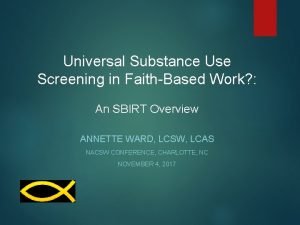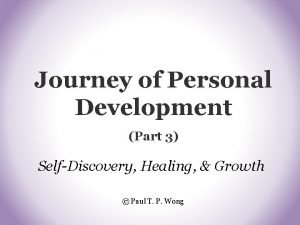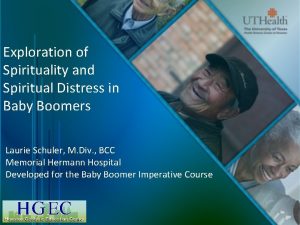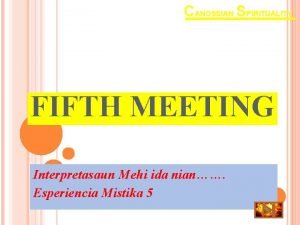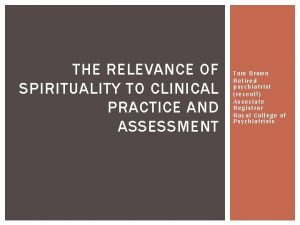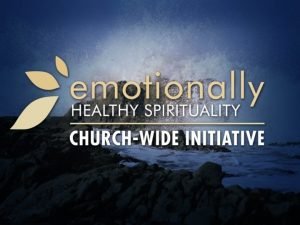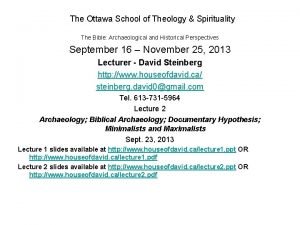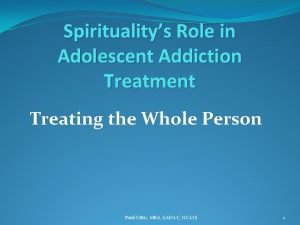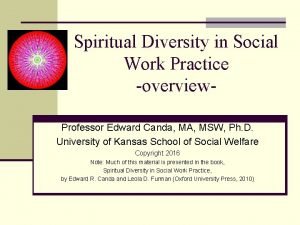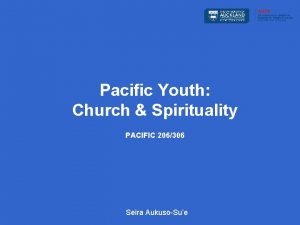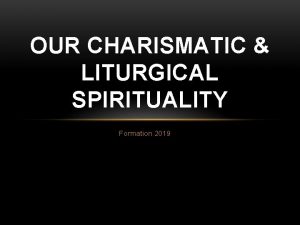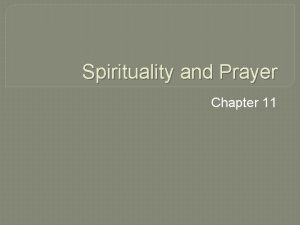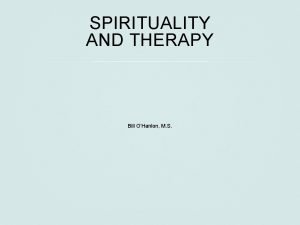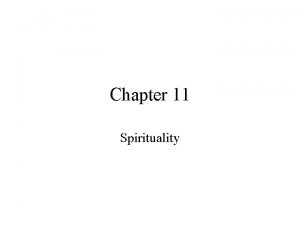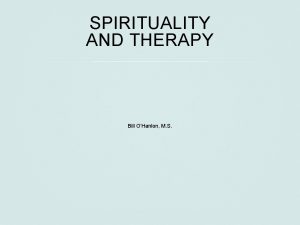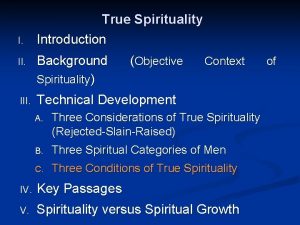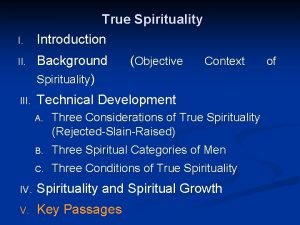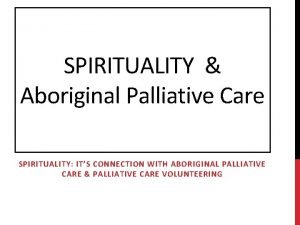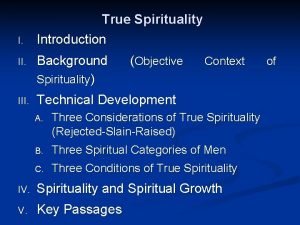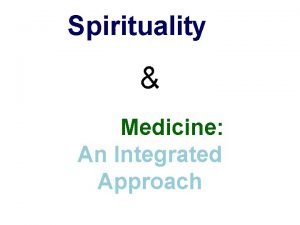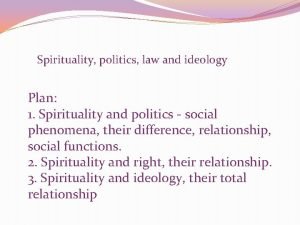Spirituality Recovery Using Spiritual Interventions in the Process



















































- Slides: 51

Spirituality & Recovery: Using Spiritual Interventions in the Process of Transforming Persons in Christ Ana Wong-Mc. Donald, Ph. D. The Salvation Army – Haven 11301 Wilshire Blvd. , Bldg. 212, 3 rd Fl. Los Angeles, CA 90073 (310) 478 -3711, x 43653 ana. wong-mcdonald@usw. salvationarmy. org

Presentation Outline n n Introduction: Research on spirituality and mental health Example: Results of a 3 -year spirituality group Application: Spirituality interventions for transformation into Christ-likeness Questions & Discussions

Important Notice n n Spiritual interventions do NOT replace professional treatment for people with severe mental illness. Mental illness is a brain disorder (see handout posted on conference website from last year). Effective treatment = medication + therapy Best treatment = medication + therapy + spiritual interventions

Introduction What do research studies show about the relationship between spirituality and mental health?

Beneficial Effects of Spirituality/Religion n Research in the last 2 decades have evidenced that spiritual and religious practices contribute to better physical health, psychological adjustment, and lower rates of problematic behavior (Miller & Thoresen, 1999; Mulligan & Mulligan, 1999; Richards & Bergin, 2000; Seybold @ Hill, 2001).

Beneficial Effects of Spirituality/Religion n n Many people with mental illness see spiritual activities as an important part of their recovery processes. They believe that spiritual concerns should be discussed with their counselors and mental health providers (Mulligan & Mulligan, 1999; Quackenbos, Privette, & Klentz, 1985; Rose, Westefeld, & Ansley, 2001; Tepper, Rogers, Coleman, & Malony, 2001; Worthington, Jurusu, Mc. Cullough, & Sanders, 1996).

Beneficial Effects of Spirituality/Religion n On individuals with n n Depression Anxiety Substance addictions Schizophrenia

Impact of Spirituality on Persons with Major Depression n Religiosity is associated with decreasing levels of depression (Catipovic, Ilakovac, Durjancek, & Amidzc, 1995; Cosar, Kocal, Arikan, & Isil, 1997; Plante & Boccaccini, 1997), especially for people with intrinsic religiosity or faith based on internal beliefs (Mickley, Carson, & Soeken, 1995; Watson, Milliron, Morris, & Hood, 1994).

Impact of Spirituality on Major Depression n Lower levels of depression among those who held a belief in an afterlife (Alvarado, Emper, Bresler, & Dobson, 1995). n Depression less likely among religious individuals with medical illness or religious surgical patients as compared with their less religious peers (Richard & Bergin, 2000).

Impact of Spirituality on Major Depression n Church attenders are half as likely to be depressed as non-attenders (Koenig et al. , 1997; Thearle, Vance, Najman, Embelton, & Foster, 1995). n In a 10 -year longitudinal study, maternal religiosity and maternal-offspring concordance of religiosity were found to be protective agents against depression for offspring (Miller, Warner, Wickramaratne, & Weissman, 1997).

Impact of Spirituality on Persons with Anxiety Disorders n Positive mental outcomes noted for people with anxiety disorders who are intrinsically religious and among those who use religious and spiritual coping mechanisms (Jahangir, 1995).

Impact of Spirituality on Anxiety Disorders n A normal healthy religious life is a protective agent against anxiety disorders. Intrinsic religiosity is associated with lower levels of general anxiety (Lotufo-Neto, 1996; Mickley et al. , 1995; Richards & Bergin, 2000). n Death-anxiety among terminally ill patients with HIV/AIDS was decreased with use of religious and spiritual coping (Woods et al. , 1999), specifically with the use of prayer (Kaplan et al. , 1997).

Impact of Spirituality on Substance Addictions n Intrinsic religiosity is related to low levels of substance use (Fischer & Richards, 1998), while the likelihood of using or relapse include a feeling of disconnectedness with one’s religion (Gills & Mubhashar, 1995). n Higher levels of religiosity or spirituality among individuals recovering from substance abuse are associated with enhanced coping, greater resilience to stress, an optimistic life orientation, greater perceived social support, and lower levels of anxiety among inpatient and halfway house substance abusers (Pardini, Plante, & Sherman, 2001).

Impact of Spirituality on People with Schizophrenia n n Religious coping methods have positive effects on persons with schizophrenia and with their families (Wahass & Kent, 1995). For the individual with schizophrenia, religious worship with the family or with a congregation may integrate the person into a greater community when s/he feels isolated. For the family, religious worship with the individual with schizophrenia serves as a means of feeling connected with the individual who has lost touch with reality (Mac. Green, 1997).

Example Results of a 3 -year spirituality group -Mc. Donald, 2007) Article is posted on conference website. (Wong

Group Description n The spirituality group (SG) was an optional group at a psychosocial rehabilitation program (psych rehab) at a community mental health center. 48 persons with severe mental illness participated in psych rehab: 20 chose to participate in SG (with signed informed consent), 28 did not. Of the 20 clients in SG, 18 professed to some type of Judeo-Christian faith while 2 were open to all faiths.

Group Description n n The recovery process based on treatment goal attainment is compared between those in SG and those not in SG. Examples of treatment goals include: n n n Wellness (e. g. , lowering frequency of panic attacks, losing weight, decreasing hospitalizations, overcoming agoraphobia) Socialization (e. g. , making a new friend, going out on a date, saving money to go on a vacation with friends) Vocational/education (e. g. , obtaining a driver’s license, earning a high school diploma, returning to college, transitioning from volunteer to paid employment)

Outcome n n n For a 3 -year period (April 2003 -April 2006) All 20 clients (100%) in SG achieved their treatment goals, as compared to 16 out of 28 (57%) clients not in SG who attained the goals. Result is significant (p <. 0001). Chi square tests were used to determine if the difference was due to ethnicity, attendance, yrs of education, diagnosis, type of goal, history of substance abuse, age, and housing arrangement. Results were all not significant.

Reports from Clients in SG n n n n Spirituality is very important in their recovery. Sensing God’s presence lessens feelings of sadness. Their faith helps them to feel calmer from fears/anxieties. Their faith helps them to forgive. They feel more confident to pray. They are more able to resolve things from a spiritual perspective. They believe that there is always hope because God is always there.

Application: Use of Spiritual Interventions to Transform Persons into Christ-Likeness What? n Who? n How? n

What? n n Spirituality refers to the lived experience of God in all aspects of life, that is rooted in the revealed word of God and grounded in the community of faith (Stevens, 2004). Intervention refers to any action a counselor takes to move the counselee toward health, well-being, and Christ-likeness.

Scriptural Basis Colossians 1: 28 -29 We proclaim Him, admonishing and teaching everyone with all wisdom, so that we may present everyone perfect in Christ. To this end I labor, struggling with all His energy, which so powerfully works in me. Galatians 4: 19 My children, with whom I am again in labor until Christ is formed in you.

Spiritual Formation Non-Christlikeness Every intervention (e. g. , becoming clean & sober, forgiveness & reconciliation, taking responsibility, seeking God, prayer) should move counselee toward Christlikeness.

Purpose of Spiritual Interventions n Affirm spiritual identity & divine worth n n Many do not know who they are in Christ Understand problems from an eternal spiritual perspective n Give biblical teachings on trials & suffering

Purpose of Spiritual Interventions n Modify erroneous spiritual beliefs n n Many have false notions about what the bible says Seek guidance and strength from God to cope and heal n Sometimes just a reminder that God is present in their troubles will help them to go on.

Purpose of Spiritual Interventions n Emotionally forgive & heal from past n n Some are stuck in the past and ruminate about wrongs done to them. Accept responsibility n Taking responsibility for one’s life is the first step. They may not be responsible for the past (i. e. , abuse that was done to them) but they are responsible for their present & future.

Purpose of Spiritual Interventions n Obtain (and offer) support from (and to) their religious community n n Being a contributing member gives a sense of well-being and belonging Grown in faith & commitment to God n All spiritual interventions should point the way to Jesus. (Richards & Bergin, 1997)

What? n Two types of spiritual interventions n Implicit n Explicit (Tan, 1996)

Implicit Interventions n n They are covert. Counselor does NOT openly or directly use spiritual resources like prayer or Scripture. Example: Counselor praying silently for the counselee. Example: Counselor becomes Christ’s presence for the counselee by modeling the love of God in a way that can be experienced interpersonally.

Explicit Interventions n n n They are more overt. Counselor directly and systematically deal with spiritual issues. Counselor uses spiritual interventions like prayer, scripture, spiritual writings and music, and may refer/help counselee connect with a church. Example: Counselor gives counselee a list of biblical passages to read/study that are applicable to the counselee’s situation. Example: Counselor opens the session with prayer and may include prayer during the session at specific moments.

Who? n n Implicit – Can be used with anyone Explicit – For counselees who agrees to accept spiritual interventions and who can benefit from them. (For psychotherapists, this involves obtaining informed consents from clients. )

Who? n Explicit interventions are contraindicated for the following counselees (Richards & Bergin, 1997): n n Those who make it clear that they do not want such interventions. Those who are psychotic (i. e. , out of touch to reality) or delusional (e. g. , believe that God gave them powers to control the weather).

Implicit/Explicit Interventions Used in Spirituality Group SPIRITUALITY GROUP n Psychosocial rehabilitation (e. g. , skills training, CBT) n Implicit interventions (e. g. , silent prayers, counselor as presence of Christ) n Explicit interventions (e. g. , open prayer inviting Spirit of God, reading Scripture, listening to spiritual music) n RESULT: 100% attained treatment goal; change in relationship with God & with neighbor. NO SPIR GROUP n Psych rehab n Implicit interventions used n Explicit interventions not used n RESULT: 57% attained txt goal; some change in relationship w/others from learning social skills and appropriate boundaries.

What? n Spiritual formation sits on 3 legs as its foundation; these 3 legs also form the basis for the spiritual interventions: n n n Spirit of God Word of God People of God (See separate table posted on conference website for definitions and examples of spiritual interventions. )

Spirit of God Psalm 127: 1 Unless the Lord builds the house, its builders labor in vain.

Spirit of God n Spiritual assessment/discernment n n Counselor prayer n n Continuous (overlap with counselor prayer) Sometimes the Holy Spirit will direct counselor to a specific group topic (like a pastor is led to a sermon topic) Listening (one ear is listening to the people, & the other is attuned to God) Before (to prepare both counselor and counselee, ask for Holy Spirit to lead session), during (can be silent to seek guidance from Holy Spirit or vocal to model for counselee), and after session (release counselee to God) Counselee prayer n Encourage counselee to seek help from God

Spirit of God n Joint counselor & counselee vocal prayer n n Spiritual relaxation & imagery n n Particularly useful for counselees who are unsure about how to pray Ask counselee to picture in their mind a soothing situation (such as them resting in the arms of Jesus) Spiritual meditation n Ask counselee to ponder on a scriptural passage or biblical story that relates to their situation

Word of God Hebrews 4: 12 For the Word of the Lord is living and active, sharper than any double-edged sword. It penetrates even to dividing soul and spirit, joints and marrow; it judges the thoughts and attitudes of the heart. Isaiah 55: 11 My Word that goes out from My mouth: It will not return to me empty, but will accomplish what I desire.

Word of God n Reference to Scripture n n Teaching spiritual concepts n n Many are ignorant of what the bible says Need to explain certain passages/concepts (e. g. , what does being salt & light mean? ) Spiritual confrontation n Point out incongruence between counselees’ beliefs/behavior and what the bible teaches

Word of God n Religious bibliotherapy n n Giving counselees spiritual literature to read that relates to their problem Memorization of Scripture n Encourage counselees to memorize scriptures relevant to their situations. Have them memorize a few “life” verses (i. e. , promises that they can cling to during difficult times). May use hymns to aid memorization.

People of God 1 Corinthians 12: 27, 26 Now you are the body of Christ, and each one of you is a part of it. If one part suffers, every part suffers with it; if one part is honored, every part rejoices with it. Galatians 6: 1 -2. . . if someone is caught in a sin, you who are spiritual should restore him gently. . . Carry each other’s burdens, and in this way you will fulfill the law of Christ.

People of God n Use biblical community n n Pray & support one another n n Encourage counselees to connect with other believers. May start by creating a loving community in the group. Encourage outside meetings & mutual support without counselor. May end session by asking: “Who will pray for Mary this week? ” Spiritual self-disclosure n Counselor shares what God taught them in a relevant situation to model and encourage.

People of God n Encouraging forgiveness n n Spiritual confrontation n n Need to define and help counselees understand what forgiveness means; share/model how to do this There are times when a caring community will loving confront a member. Service to others n Encourage (may create) loving acts to others in group and in community (e. g. , volunteering at a board & care home)

How? The following approach was used in the Spirituality Group with people who have mental illness, but can be adapted into other settings. n n n Start from ground zero Use material that is fairly easy to read (no higher than high school level) Go slower. Use repetition. Some have cognitive deficits. Use handouts and visual aids.

How? The following approach was used in the Spirituality Group with people who have mental illness, but can be adapted into other settings. n n n Watch attention spans. Vary modality with music, lecture, reading aloud, discussion, and video. Do NOT “dumb” down the content Do NOT accept less accountability than “normal” people

Process of Transformation 1. Knowing Faith comes by hearing, and hearing by the Word of God (Romans 10: 17). 2. Being I desire to do Your will, O my God; Your law is within my heart (Psalm 40: 8). The fruit of the Spirit is love, joy, peace, patience, kindness, goodness, faithfulness, gentleness and self-control (Galatians 5: 22 -23). 3. Doing Faith by itself, if it is not accompanied by action, is dead (James 2: 17).

Case Examples Sharon: History of domestic violence and involvement w/aggressive impulsive males n Knowing: Learned biblical principles, healthy boundaries, job skills n Being & Doing: Took responsibility to grow; returned to church and saw pastor regularly; started leading group on boundaries in domestic violence shelter; graduated from DV program, moved into own apartment; stopped dating aggressive male when she noticed warning signs; today she is employed by the Dept. of Mental Health as a peer counselor helping other clients

Case Examples Ricky: Bipolar Disorder, history of risky sexual behaviors n Knowing: Learned what the Bible says about appropriate and healthy sex n Being & Doing: Stopped these behaviors for over a year; donated money that he would have used on prostitutes to charity; channeled energies into returning to school

Goal of Spiritual Interventions Ephesians 4: 14 -16 Then we will no longer be infants, tossed back and forth by the waves, and blown here and there by every wind of teaching and by the cunning and craftiness of men in their deceitful scheming. Instead, speaking the truth in love, we will in all things grow up into Him who is the Head, that is Christ. From Him the whole body, joined and held together by every supporting ligament, grows and builds itself up in love, as each part does its work.

Questions & Discussions

Thank you!
 1 corinthians 2:9-13
1 corinthians 2:9-13 The process of spiritual growth
The process of spiritual growth Sbirt faith and spirituality
Sbirt faith and spirituality G12 core values
G12 core values Ways to improve spiritual wellness
Ways to improve spiritual wellness Spirituality definition
Spirituality definition 5 elements of salesian youth spirituality
5 elements of salesian youth spirituality Aboriginal spirituality sacred texts
Aboriginal spirituality sacred texts Mi'kmaq spirituality
Mi'kmaq spirituality Spirituality vs religion
Spirituality vs religion Spirituality definition
Spirituality definition Canossian spirituality
Canossian spirituality 4 principles of spirituality
4 principles of spirituality Four pillars of franciscan spirituality
Four pillars of franciscan spirituality Spirituality in clinical practice
Spirituality in clinical practice The problem of emotionally unhealthy spirituality
The problem of emotionally unhealthy spirituality Benedictine spirituality in everyday life
Benedictine spirituality in everyday life Ottawa school of theology and spirituality
Ottawa school of theology and spirituality Spirituality and addiction
Spirituality and addiction Joan chittester. spirituality for the long haul
Joan chittester. spirituality for the long haul Korean work
Korean work Characteristics of a pure heart
Characteristics of a pure heart 4 principles of indian spirituality
4 principles of indian spirituality Importance of spirituality
Importance of spirituality Religious vs spiritual
Religious vs spiritual Spirituality meaning
Spirituality meaning Samoan spirituality
Samoan spirituality Liturgical spirituality
Liturgical spirituality Disaster recovery process flow diagram
Disaster recovery process flow diagram Hình ảnh bộ gõ cơ thể búng tay
Hình ảnh bộ gõ cơ thể búng tay Bổ thể
Bổ thể Tỉ lệ cơ thể trẻ em
Tỉ lệ cơ thể trẻ em Chó sói
Chó sói Glasgow thang điểm
Glasgow thang điểm Chúa yêu trần thế alleluia
Chúa yêu trần thế alleluia Các môn thể thao bắt đầu bằng tiếng nhảy
Các môn thể thao bắt đầu bằng tiếng nhảy Thế nào là hệ số cao nhất
Thế nào là hệ số cao nhất Các châu lục và đại dương trên thế giới
Các châu lục và đại dương trên thế giới Công của trọng lực
Công của trọng lực Trời xanh đây là của chúng ta thể thơ
Trời xanh đây là của chúng ta thể thơ Mật thư anh em như thể tay chân
Mật thư anh em như thể tay chân 101012 bằng
101012 bằng độ dài liên kết
độ dài liên kết Các châu lục và đại dương trên thế giới
Các châu lục và đại dương trên thế giới Thể thơ truyền thống
Thể thơ truyền thống Quá trình desamine hóa có thể tạo ra
Quá trình desamine hóa có thể tạo ra Một số thể thơ truyền thống
Một số thể thơ truyền thống Cái miệng nó xinh thế
Cái miệng nó xinh thế Vẽ hình chiếu vuông góc của vật thể sau
Vẽ hình chiếu vuông góc của vật thể sau Thế nào là sự mỏi cơ
Thế nào là sự mỏi cơ đặc điểm cơ thể của người tối cổ
đặc điểm cơ thể của người tối cổ


